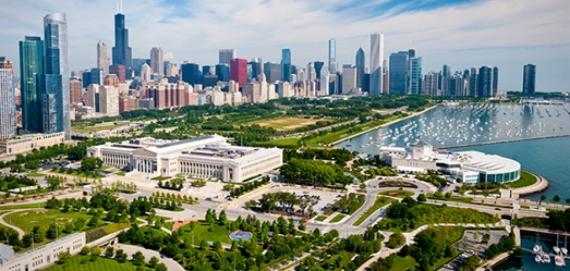


Proudly referred to as "Chicago's Front Yard," Grant Park totals 312.98 acres and is a public park located in Chicago’s central business district in the Loop Community area. Grant Park’s most notable features include Millennium Park, Maggie Daley Park, Buckingham Fountain, the Art Institute of Chicago and the Museum Campus.
A city centerpiece much like New York’s Central Park, Grant Park is home to some of Chicago's most iconic landmarks and attractions. The park includes Museum Campus, the site of world-class museums the Art Institute of Chicago, the Field Museum of Natural History, the Shedd Aquarium and the Adler Planetarium. Grant Park's centerpiece is the Clarence Buckingham Memorial Fountain, built in 1927 to provide a monumental focal point while protecting the park's breathtaking lakefront views.
Grant Park is also home to baseball diamonds, tennis courts and breathtaking gardens. The park plays host to some the city's largest food and music festivals, including The Taste of Chicago — a large food and music festival held around the Independence Day holiday — and The Grant Park Music Festival. Grant Park is also the site of the start and finish lines for the Chicago Marathon and Lollapalooza, a popular outdoor music festival.
Grant Park has been the site of many large, historic civic events. In 1911, it hosted the major Chicago International Aviation Meet. In 1968, it was the scene of clashes between Chicago Police and demonstrators during the Democratic National Convention. In 1979, Pope John Paul II delivered an outdoor mass to a large crowd in the par,k, and in the 1990s, championship celebrations for the Chicago Bulls were staged here. The park was also the location for President Barack Obama's Election Day victory speech on the night of November 4, 2008.
Named for U.S. President and Civil War General Ulysses S. Grant, Grant Park was developed as one of Chicago's first parks and expanded through land reclamation. The park was the focus of several disputes in the late 1800s and early 1900s over open space use. It is bordered on the north by Randolph Street, on the south by Roosevelt Road, on the west by Michigan Avenue and on the east by Lake Michigan.
Grant Park offers many different attractions in its large open space. The park is generally flat. It is crossed by large boulevards and pedestrian bridges are used to connect Millennium Park and Maggie Daley so that patrons may cross S. Columbus Drive with ease. There are also several parking garages underneath the park, near Michigan Avenue.
Millennium Park
The northwestern corner of Grant Park was renovated between 1998 and 2004 to become Millennium Park, a contiguous area with a variety of artistic features by architects and artists. Millennium Park features some of Chicago's most popular attractions, including the Jay Pritzker Pavilion, Cloud Gate, the Crown Fountain and the Lurie Garden. The park is connected to Maggie Daley and the east side of Grant Park by the BP Pedestrian Bridge and the Nichols Bridgeway.
Maggie Daley Park
The former Daley Bicentennial Plaza site was transformed into magnificent Lakefront recreation center now called Maggie Daley Park. The park features an ice skating ribbon, a fieldhouse, a massive playground apparatus and a climbing wall. The Skating Ribbon at Maggie Daley provides a skating experience unlike any other. With the City’s skyline as a backdrop, park patrons can skate along a ribbon of ice integrated into the landscape for a multisensory, “alpine in the city” experience. The ribbon's winding path provides twice the length of a lap around a traditional skating rink. Complementing the ribbon are places to enjoy a cup of hot chocolate, rent skates and scale the climbing wall. In the summertime, the ribbon is used for roller-skating and scooters, gallery exhibitions and special events.
The Field House in Maggie Daley Park is the central hub for indoor and outdoor programming throughout the seasons. Traditional Chicago Park District programming such as Day Camps is offered, as well as specialized activities that utilize the new park features, including the climbing park and skating ribbon. Some rental spaces are available in the field house for special events.
Buckingham Fountain
The center piece of Grant Park is Buckingham Fountain, one of the world's largest fountains. The fountain, built in a rococo wedding cake style, was dedicated in 1927 as a gift to the city from Kate Sturges Buckingham in memory of her brother Clarence. The fountain operates seasonally, generally from May to October, with water displays every 20 minutes and a light and water display from 9:00-10:00 p.m.
Congress Plaza
Congress Plaza is located in the center of Grant Park on its west side. The two semicircular plazas, created by East Congress Plaza Drive and bisected by East Congress Parkway, contain gardens, fountains and artwork, including the large bronze warrior statues, "The Bowman" and "The Spearman" that are positioned like gatekeepers to the park.
Petrillo Music Shell
The Petrillo Music Shell is home music performances and large, annual events, including the Chicago Jazz Festival, Taste of Chicago and Lollapalooza. Located at 235 S. Columbus Drive, the music shell's area encompasses the entire block bounded by Lake Shore Drive to the east, Columbus Drive to the west, East Monroe Street to the north and East Jackson Street to the South. The structure was relocated to this site in 1978 from the south end of the park. The amphitheater and paved surface for public seating is in the southwest corner.
Museum Campus
Chicago's Museum Campus is a 57-acre addition to Grant Park's southeastern end. The Museum Campus is the site of three of the city's most notable museums, all dedicated to the natural sciences: Adler Planetarium, Field Museum of Natural History, and Shedd Aquarium. A narrow isthmus along Solidarity Drive, dominated by Neoclassical sculptures of Kosciuszko, Havlicek and Copernicus, connects to Northerly Island where the planetarium is located.
Art Institute of Chicago
Built in 1893 and sitting on the western edge of Grant Park, the Art Institute of Chicago is one of the premier art museums and art schools in the United States. The Institute is known especially for the extensive collection of Impressionist and American art, such as "A Sunday Afternoon on the Island of La Grande Jatte" and "American Gothic."
Hutchinson Field
Much of the southern end of Grant Park is given over to Hutchinson Field, an open space for large events and a dozen baseball or softball diamonds.
Chicago Lakefront Trail
The Chicago Lakefront Trail is an 18-mile multi-use path along the coast of Lake Michigan. It is popular with cyclists and joggers. From north to south, it runs through Lincoln Park, Grant Park, Burnham Park and Jackson Park.
Marinas and Harbors
There are two pleasure and leisure boat marinas on Lake Michigan, which are accessed from Grant Park. Monroe Harbor provides 1000 mooring cans, tender service, and facilities in the expansive harbor east of the park. It is the home of the Chicago Yacht Club and the Columbia Yacht Club. DuSable Harbor (formerly Chicago Harbor), northeast of the park, offers 420 boat docks and a harbor store. Both harbors may be accessed off Lake Shore Drive near Monroe Street.
The Skate Park in Grant Park
The Chicago Park District transformed 1.86 acres of open space at the southwest corner of Grant Park into a new recreational space with an outdoor event/art exhibit space and a multi-use recreation area with wheel-friendly elements for scooters, rollerblades, skate boards and BMX bikes. The skate park's design elements include multi-skill level concrete ramps, grinding rails and handrails, bench seating and native landscape plantings, among other site amenities.
Grant Park's beginnings date to 1835, when foresighted citizens, fearing commercial lakefront development, lobbied to protect the open space. As a result, the park's original area east of Michigan Avenue was designated "public ground forever to remain vacant of buildings."
Officially named Lake Park in 1847, the site soon suffered from lakefront erosion. The Illinois Central Railroad agreed to build a breakwater to protect the area in exchange for permission for an offshore train trestle. After the Great Fire of 1871, the area between the shore and trestle became a dump site for piles of charred rubble, the first of many landfill additions.
In 1901, the city transferred the park to the South Park Commission, which named it for Ulysses S. Grant (1822-1885), 18th President of the United States. Renowned architect Daniel H. Burnham envisioned Grant Park as a formal landscape with museums and civic buildings. However, construction was stalled by lawsuits launched by mail-order magnate Aaron Montgomery Ward, who sought to protect the park's open character.
Finally, in 1911, the Illinois Supreme Court ruled in Ward's favor. New landfill at the park's southern border allowed construction of the Field Museum to begin, and the park evolved slowly. In 1934, the South Park Commission was consolidated into the Chicago Park District, which completed improvements using federal relief funds.
At the turn of the 21st century, the north end of Grant Park is undergoing a multi-million-dollar facelift, as old railbeds are transformed into Millennium Park, a major landscape and festival site."
Mobility
Deaf and Hard of Hearing
Blind and Low Vision
Sensory Friendly Location
Ushering Services
Ushers (wearing purple shirts) are located throughout the park on concert nights and are available to assist all patrons with directions, seating, and other requests.
Patron Services Location and Hours
The Patron Service Center is located on the west walkway of the Pavilion and opens 90 minutes before concerts.
Patron Services can be contacted Monday through Friday between 10am-4pm at patronservices@gpmf.org or by calling 312.742.7647.
Other Grant Park Music Festival Events
Services for Grant Park Music Festival events not located at the Jay Pritzker Pavilion in Millennium Park vary. Please contact Patron Services for more accessibility information for those events.


Latest Reviews
-
Michael Holden
05 Mar 2019
3.0



Parking: 1.0
Accessibility: 4.0
Toilets: 2.0
Staff: 1.0
Grant Park is beautiful and nestles on the lake, We meandered through the park on our stroll from Navy Pier to The Field Museum. There are no toilets in the park though, only a series of plastic portable potties.

Read All Reviews